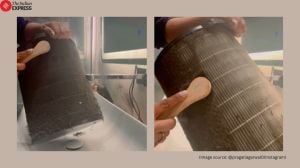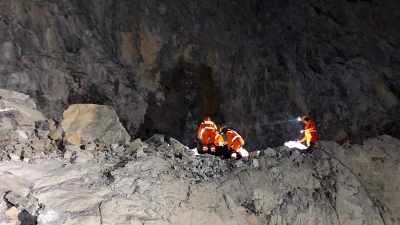Homes flooded with industrial chemicals in some Jodhpur villages, residents are told to move out
Several gram panchayats in Jodhpur and Balotra recently sent an unusual notice asking their residents to temporarily evacuate after their homes filled with floodwater from the nearby Jojri. The notice highlighted a decade-old problem – that of industrial wastewater being discharged into rivers.
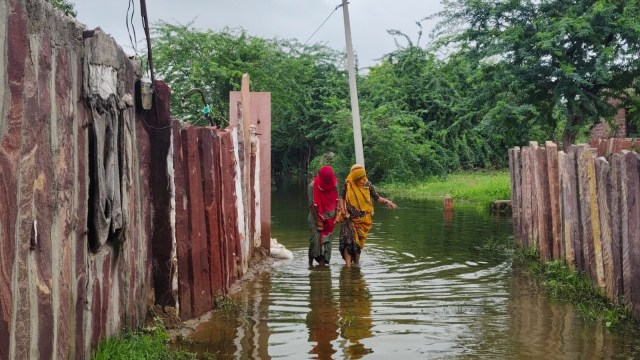 A view of a flooded road in Doli gram panchayat, Jodhpur. (Express Photo by Parul Kulshrestha)
A view of a flooded road in Doli gram panchayat, Jodhpur. (Express Photo by Parul Kulshrestha)Indra Devi squats under a tarpaulin tent, intently stirring a pot of bajra ka khichda that she’s cooking for lunch. A makeshift home in the middle of her family’s five bigha farm in Jodhpur’s Araba Dudawatan, the tent only has a chulha, some odd pots and pans, a couple of charpai beds and some clothes – things that she and her family managed to gather as they fled their flooded home.
“The courtyard wall of my house is cracked because of the chemical water that flooded my home three months ago,” the 28-year-old says.
On July 28, Araba Dudawatan and Doli gram panchayats in Jodhpur and Balotra districts asked 15 households — including Indra and her family — to temporarily evacuate their homes after heavy rain caused the nearby Jojri rivers to flood the area.
It highlighted a decade-old problem that these parts are grappling with – water pollution, allegedly caused by industries releasing untreated effluents into the nearby Jojri, Bandi, and Luni rivers.
According to residents, while the problem becomes acute in the monsoon, this is the first time villages have been asked to clear out.
The notices were issued in the aftermath of the Jhalawar episode, Vanfool Singh from Jodhpur’s Araba Dudawatan village alleges, referring to the collapse of a roof at a government school in July, killing seven students.
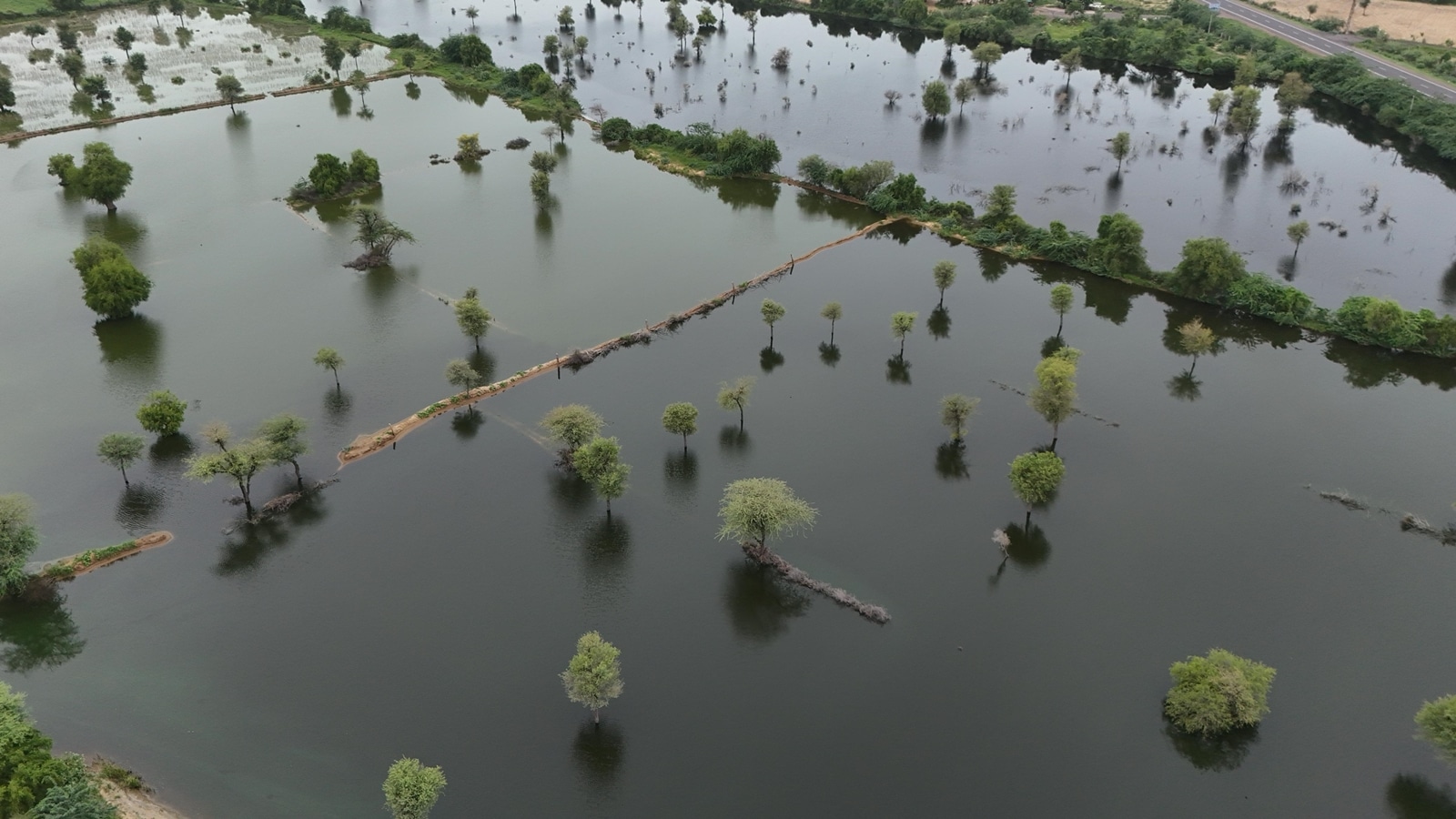 A bird’s eye view of flooded fields in Jodhpur. (By special arrangement/Shravan Patel)
A bird’s eye view of flooded fields in Jodhpur. (By special arrangement/Shravan Patel)
“The administration sent this notice on July 28 just to save themselves,” Singh says.
Village development officer Bheema Ram confirms that notices were issued to 10 houses in Araba “to avoid any accidents”.
But for families like Indra Devi’s, the uncertainty of how long this will last is harrowing.
“When we received the orders from the Gram Panchayat Araba Purohitan, we decided to shift to our field since we had no other place to go,” she says.
Jodhpur’s ‘chemical’ floods
According to the Pollution Control Department of Rajasthan, there are over 300 textile industries in Jodhpur and 700 dyeing units in Balotra district, making it a major textile hub.
Jodhpur is known for its 300-year-old tradition of block printing – a technique of using carved woodblocks to stamp coloured designs on fabric. However, in the 1970s, screenprint began to edge out the traditional art.
According to Madan Meena, a trustee of Gujarat’s Bhasha Research and Publication Centre, while the traditional dyes were made of plant-based colours made from roots, leaves, and stems, modern-day screen printing uses dyes with high lead and acid content.
 Bhanwari and her husband are living at their relatives’ home. (Express Photo by Parul Kulshrestha)
Bhanwari and her husband are living at their relatives’ home. (Express Photo by Parul Kulshrestha)
In a report on water quality in Pali, Jodhpur and Balotra in 2008, the Delhi-based Centre for Environment Education (CEE) and the US based non-profit Blacksmith Institute found that wastewater discharged from these textile units contains about 20 percent of the dyes, “which has caused degradation of water quality in this water-scarce, semi-arid region of the country”.
Over the years, pollution became a subject of public debates too: at a rally on August 18, Nagaur MP Hanuman Beniwal highlighted the pollution and accused the state government of not doing enough to revive the Jojri river.
In 2015, after years of protest and a long battle with the district administration, the gram panchayat Araba moved the National Green Tribunal. In its ruling in 2021, the NGT directed the Rajasthan State Pollution Control Board to ensure that “no untreated, or partly treated pollutant is discharged in water or water bodies or land including rivers in question, which do not comply with the environmental laws and norms and any industry including operators of ETP, STP or CETP shall be closed/sealed, if violation is found to have continued”.
It also imposed costs of Rs 2 crore on the local authorities of Barmer and Jodhpur.\
“The NGT clearly said that untreated water cannot be sent to people’s farms and it should be covered. It also asked the government to make a plan for a Common Effluent Treatment Plant (CETP) plant big enough to treat this water. But nothing has been done,” Shatrughan Rajpurohit, resident of Araba Dudawatan and the lawyer who helped move the Rajasthan High Court, alleges.
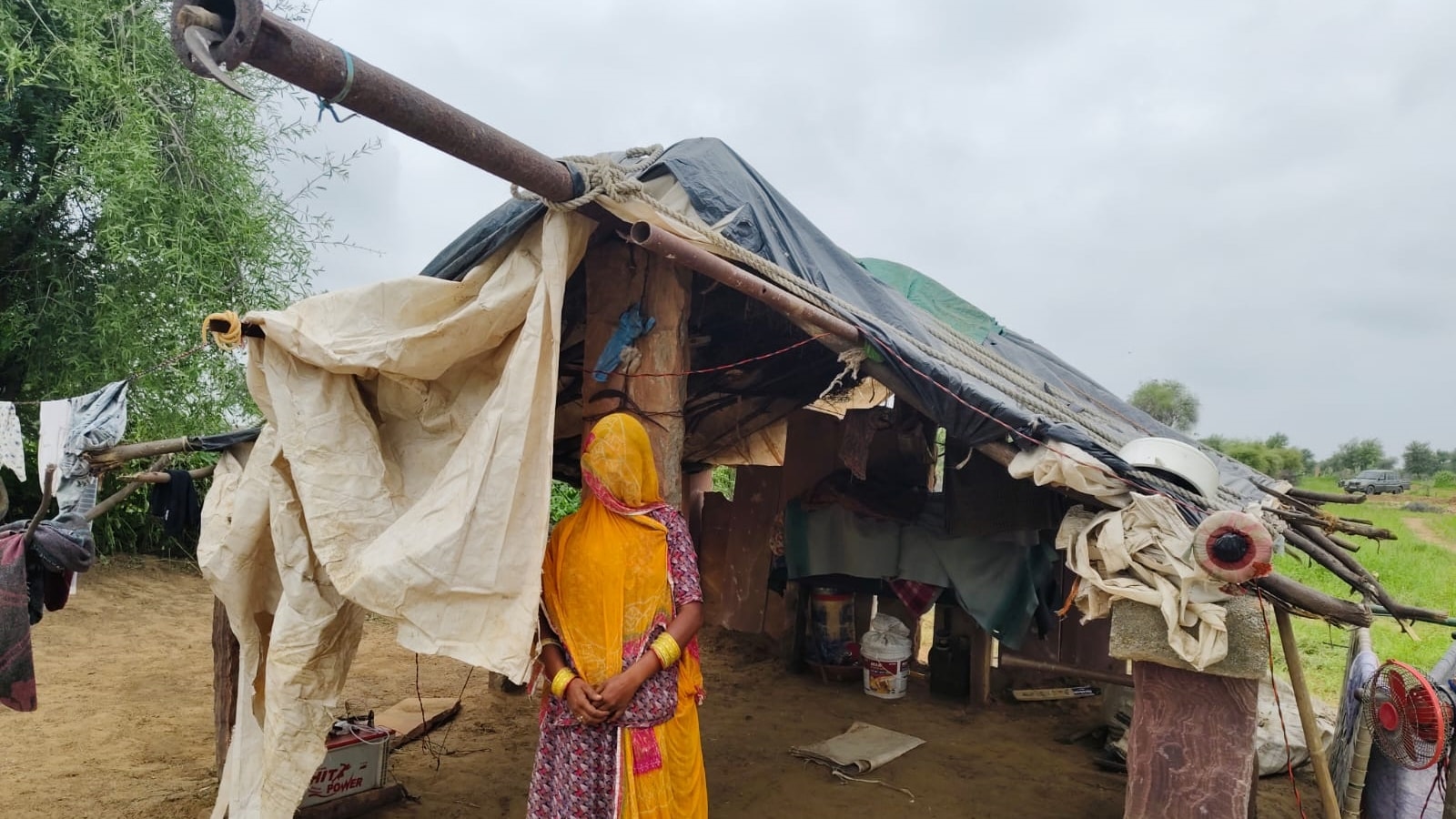 Indra Devi in front of her makeshift tarpaulin tent in Jodhpur’s Araba Dudawatan gram panchayat. (Express Photo by Parul Kulshrestha)
Indra Devi in front of her makeshift tarpaulin tent in Jodhpur’s Araba Dudawatan gram panchayat. (Express Photo by Parul Kulshrestha)
In its notice in July, the Araba Gram Panchayat asked village residents to clear their homes “due to the increased flow of chemicals coming from Jodhpur”.
“Everyone should evacuate their houses and take their valuables to a safe place. If you fail to evacuate your house, you will be responsible for it. Please stay informed,” the notice said.
Before the notice came, village residents were already feeling the effects of the “chemical flood”. When Bhera Ram Bheel passed away from a long illness on July 24, his family had no place to cremate him because the local Bheel crematorium had gone five feet under.
As a result, the family held a road blockade to demand a place for cremation. “We eventually cremated him on the side of the highway,” his father Rama Ram Bheel says.
But if the flood wreaked havoc, the gram panchayat’s notice has made matters worse. In another part of Araba, Bhanwari Devi and her husband Tejaram Naayi have now moved to their relative’s house.
“My house is not liveable. My children and grandkids are living in the fields while my husband and I are at our relative’s house. How long are we going to survive like this?” she asks.
And it’s not only humans that the industrial wastewater affects. According to activists, the area is home to wildlife such as blackbucks, chinkara, foxes, jackals, wolves, and porcupines. “The river is a source of water to them. Chinkara and blackbucks have been found dead from drinking this water,” Jodhpur wildlife conservationist Shravan Patel says.
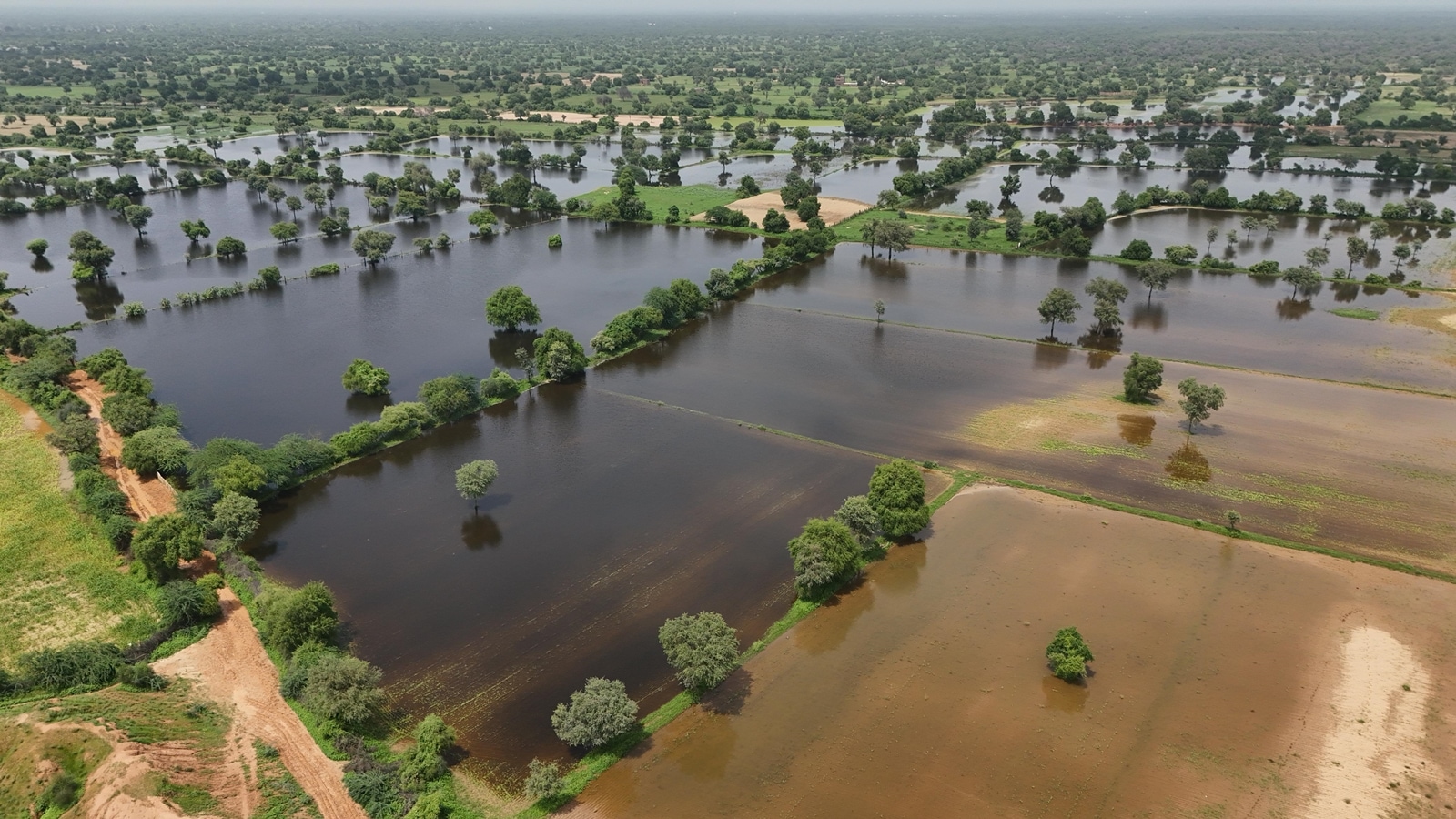 A bird’s eye view of flooded fields in Jodhpur. (By special arrangement/Shravan Patel)
A bird’s eye view of flooded fields in Jodhpur. (By special arrangement/Shravan Patel)
Official efforts
Officials, however, believe that it’s the untreated sewage that’s the real challenge. According to Kamini Sonagra, the Jodhpur regional officer for the Rajasthan State Pollution Control Board — with its population of 15 lakh people — churns out about 230 Million Litres per Day (MLD) of domestic sewage, of which only about 100 MLD gets treated.
Meanwhile, toxic industrial waste from factories is 18 MLD out of which 2 MLD is treated.
But Sonagra also admits that the Common Effluent Treatment Plants (CETP) plant in Jodhpur is insufficient and doesn’t always function to its optimal capacity. “A major chunk of waste is coming from domestic waste that could be sorted out if the CEPT starts working properly and is upgraded to support capacity,” she says.
Meanwhile, Jodhpur has three Sewage Treatment Plants (STPs) with a total capacity of 120 MLD against the requirement of five. According to Sonagra, three more are under construction and more have been proposed.
Then there’s the problem of the 350-odd illegal textile factories that function in the area. While the department conducts raids from time to time – the last one being in February — officials admit that crackdown is not always effective
On its part, the district administrations of Jodhpur and Balotra say they are working to find a permanent solution. Officials also say there are plans to rejuvenate the Jojri river – in its Budget announcements in February, Rajasthan’s Bharatiya Janata Party announced a Rs 176 crore revival project that included a river front.
But there has been little movement on that front, with activists blaming it on the “lack of political will”.
“Before the Lok Sabha elections, Jodhpur MP Gajendra Singh Shekhawat inaugurated the Jojri river front, which was supposed to have a treatment plant. But nothing has been done so far,” wildlife conservationist Shravan Patel says.
The Indian Express has sent a list of questions to Shekhawat but has yet to get a response.
For residents of these villages, all this means battling a problem with no end in sight.
“The court can order. It’s the government that has to implement it,” the advocate, Shatrughan, says. “I think my fate is to see my village being destroyed a little more each day.”




